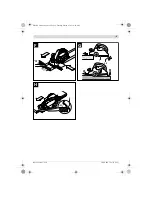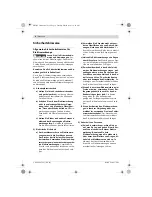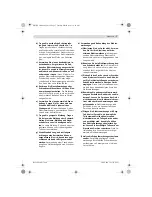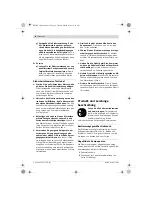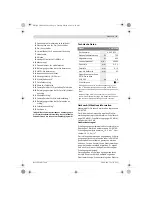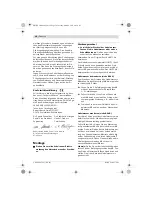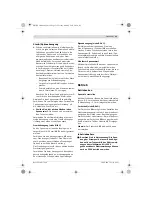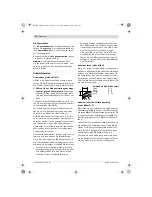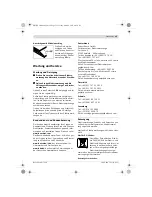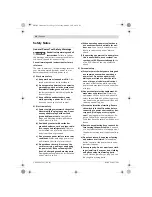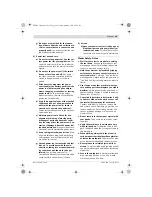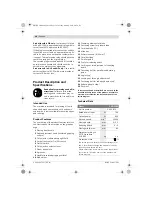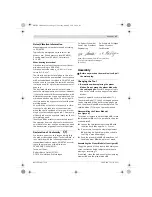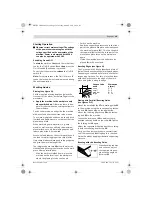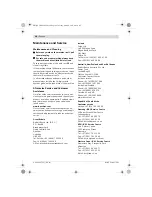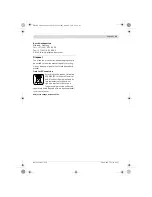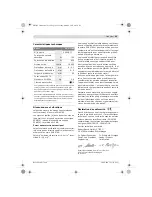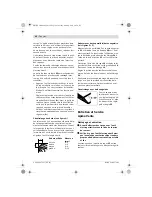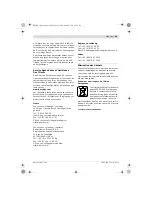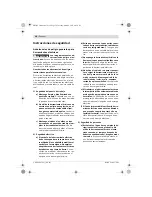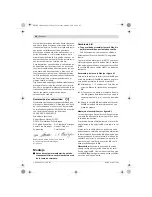
English |
19
Bosch Power Tools
2 609 140 721 | (8.3.11)
Starting Operation
f
Observe correct mains voltage! The voltage
of the power source must agree with the
voltage specified on the nameplate of the
machine. Power tools marked with 230 V
can also be operated with 220 V.
Switching On and Off
To
start
the machine,
first
push the lock-off but-
ton for the On/Off switch
4
and
then
press the
On/Off switch
5
and keep it pressed.
To switch off the machine,
release
the On/Off
switch
5
.
Note:
For safety reasons, the On/Off switch
5
cannot be locked; it must remain pressed during
the entire operation.
Working Advice
Planing (see figure G)
Set the required planing depth and place the
front part of the planer base plate
7
against the
workpiece.
f
Apply the machine to the workpiece only
when switched on.
Otherwise there is dan-
ger of kickback when the cutting tool jams in
the workpiece.
Switch the machine on and guide the machine
with even feed over the surface to be planed.
To achieve high-grade surfaces, work only with
low feed and apply pressure on the centre of the
planer base plate.
When machining hard materials (e.g. hard-
wood) as well as when utilising the maximum
planer width, set only low planing depths and
reduce planer feed, as required.
Excessive feed reduces the surface quality and
can lead to rapid clogging of the chip ejector.
Only sharp blades achieve good cutting capacity
and give the machine longer life.
The integrated park rest
25
also allows for con-
tinued planing at any given location on the work-
piece after an interruption:
– With the park rest folded down, place the
machine on the location of the workpiece
where the planing is to be continued.
– Switch on the machine.
– Apply the supporting pressure onto the front
part of the planer base plate and slowly push
the machine forward (
n
). This tilts the park
rest upward (
o
) so that the rear part of the
planer base plate faces on the workpiece
again.
– Guide the machine over the surface to be
planed (
p
) with even feed.
Beveling Edges (see figure H)
The V-grooves in the front planer base plate al-
low quick and easy beveling of workpiece edges.
Depending on required bevel width, use the cor-
responding V-groove. For this, place the planer
with the V-groove onto the edge of the work-
piece and guide it along the edge.
Planing with Parallel/Beveling Guide
(see figures D–F)
Mount the parallel guide
17
or beveling guide
21
to the machine using the corresponding fasten-
ing bolt
20
. Depending on the application,
mount the rebating depth stop
24
with fasten-
ing bolt
23
to the machine.
Loosen the locking nut
19
and adjust the re-
quested rebating width on the scale
18
. Tighten
the locking nut
19
again.
Adjust the requested rebating depth according-
ly with the rebating depth stop
24
.
Carry out the planing procedure several times
until the requested rebating depth is reached.
Guide the planer applying sideward supporting
pressure.
Beveling with the Beveling Guide
When beveling rebates
and surfaces, adjust
the required slope an-
gle with the angle ad-
justment
22
.
Groove to be
used
Dimension
a (mm)
none
0 – 4
small
2 – 6
medium
4 – 9
large
6 – 10
OBJ_BUCH-406-003.book Page 19 Tuesday, March 8, 2011 8:05 AM

